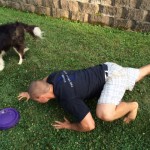Good Morning,
I hope you all enjoyed your weekends. I did as I was able to get down to the celebration at my local farmer’s market that was celebrating it’s 262nd anniversary as the longest running outdoor market in the USA. Thank you everybody down at the Easton Farmer’s Market who continues to serve us with great food to keep us healthy.

Rufus always wants to play frisbee
Can I Move Like a Baby? (part 3)
We have come to the last part of our “Can I Move Like a Baby” series and I am wondering…can you do it? Have you taken the time to try these new movements? Did you begin following Dr. Diet’s principles that we addressed last quarter to make sure that your abdominal wall was functioning properly? I am curious to know so please leave a comment below or on Facebook as to which movements you are still finding challenging.
Homolateral Pattern
Now that we have been learning to integrate upper and lower halves of the body we will now move into integrating the left and right. This is beginning to progress infant development to around 5-8 months of age. I want to again remind you that mastering the previous patterns is a must before going on. The body has great knowledge and will still resist trying to skip stages.
Testing here can begin from having the client lie on their stomach and put an object just out of reach of their outstretched arm. I am looking for an elongation of that entire side of the body.
Contralateral Pattern
Time to crawl! Now it is time to watch for integration of the opposite arm and opposite leg. I will assess this through two different types of crawl. The first would be the reptilian. It is just as it sounds, crawling like a lizard. Get the belly low to the ground and check to see that the spine is moving fluidly as well as the person having overall strength to perform. Many people cannot properly support their own bodyweight. Then I would ask them to crawl forward and backward like a baby on their hands and knees. We want to make sure that both directions can be done, again with a fluid spine. It also must be noted that many people will move one whole side at a time. It should again be opposite arm and opposite leg.
I again love Swiss Ball work to help with crawling patterns if they are too weak to perform or need extra work. To assist the contralateral pattern my favorites is the Supine Lateral Ball Roll. Many others can be done for strengthening after, but I find this is the best to start with in my clients and myself.

Still playing frisbee while I show the reptilian crawl pattern
Gait
Finally we are up on our feet and moving, not just squatting up and plopping back over. This is important to assess with each individual as there are often differences in arm swing, hip hiking, stride length and speed side to side, among many other discrepancies. This can looked at during walking, running and sprinting as form will change with each, but all should be fluid and equal side to side.
I still cannot stress enough that going back to parts 1 and 2 before addressing what we have covered here in part 3 is a must. Have fun moving like a baby and get ready as we move on to working out next week!
Have a Great Day!
Nick Horowski
